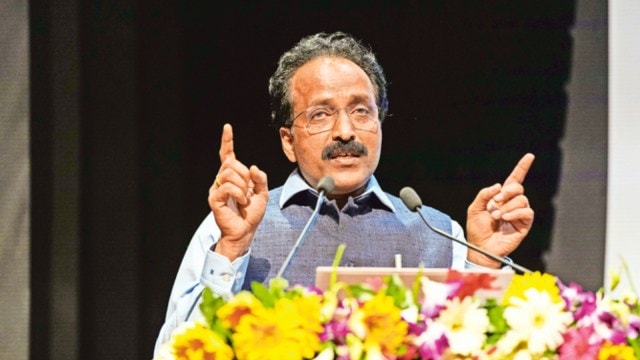ISRO chief sets new dates: 2026 for Gaganyaan, Chandrayaan-4 likely in 2028
The ISRO chairman disclosed that a joint moon-landing mission with Japan space agency JAXA, originally named LUPEX, or Lunar Polar Exploration, would be the Chandrayaan-5 mission. He did not mention the expected time frame for launch.
 ISRO chairman S Somanath in New Delhi, Saturday. PTI
ISRO chairman S Somanath in New Delhi, Saturday. PTIEmphasising the need for greater indigenisation of space technologies, ISRO chairman S Somanath on Saturday said India was aiming to increase its contribution in the global space economy to at least 10 per cent in the next one decade, from the current 2 per cent.
Delivering the Sardar Patel Memorial Lecture at Akashvani (All India Radio), Somanath also revealed new dates for some important upcoming missions: Gaganyaan, the manned space mission, likely in 2026; sample return mission Chandrayaan-4 in 2028; and the much-delayed India-US joint NISAR mission is finally slated for next year.
The ISRO chairman disclosed that a joint moon-landing mission with Japan space agency JAXA, originally named LUPEX, or Lunar Polar Exploration, would be the Chandrayaan-5 mission. He did not mention the expected time frame for launch. The LUPEX mission was earlier scheduled to be launched within the 2025 time frame, but now that it has been described as Chandrayaan-5, it can only be expected after 2028 when Chandrayaan-4 is scheduled.
“It would be a very heavy mission in which the lander would be provided by India, while the rover would come from Japan. The rover on Chandrayaan-3 was only about 27 kg in weight. But this mission would carry a 350-kg rover. It is a science heavy mission which would take us one step closer to landing human beings on the moon,” Somanath said. India has unveiled plans of having a manned mission to the moon by 2040.
Somanath said opening of the space sector to private enterprise, new enabling policies, and the enthusiasm shown by young entrepreneurs had created a vibrant space ecosystem in India.
“But our contribution to the global space economy is still about 2 per cent. Our aspiration is to increase it to about 10 per cent in the coming 10-12 years. But ISRO cannot achieve this alone. We need participation of other stakeholders. Start-ups to big companies, all need to come and participate in India’s space sector. We have been working hard to create those enabling mechanisms that will make it easy for companies to work with ISRO,” he said.
“Several industries, big and small, have expressed interest in investing in the space sector. And ISRO is doing its best to help them come and participate. Lots of activities which could traditionally be done only by ISRO are now being done by private industry. Rockets are a good example. These kinds of things were already happening in some other countries. These have begun to take shape in India as well. We are helping, empowering, guiding these companies,” Somanath said.
The ISRO chairman said India’s dependence on imports of space technologies had decreased significantly in the last one decade, but there was much more that needed to be done, including manufacturing and research and development.
“A lot of critical items used in the space sector still come from outside. We will have to create the capability to build a lot of these within our country. There has to be greater indigenisation of advanced research and development as well,” he said.
Somanath said while India had a very old and rich tradition of observing and studying stars and galaxies, it was after a long time that the country was producing new knowledge in the field of astronomy and contributing to global efforts in space exploration.
“Chandrayaan-3 was not just about making a soft-landing on the Moon. It was of course important, but the mission also produced very interesting scientific outcomes. Even Chandrayaan-1 produced excellent science outcomes, it confirmed the presence of water on the moon. Same is the case with Aditya-L1 and XPoSat missions. All of them are generating new science and data that progresses the global knowledge. Astrosat (which has been operational since 2015), for example, has resulted in more than 400 scientific papers and over 30 PhDs,” Somanath said.







